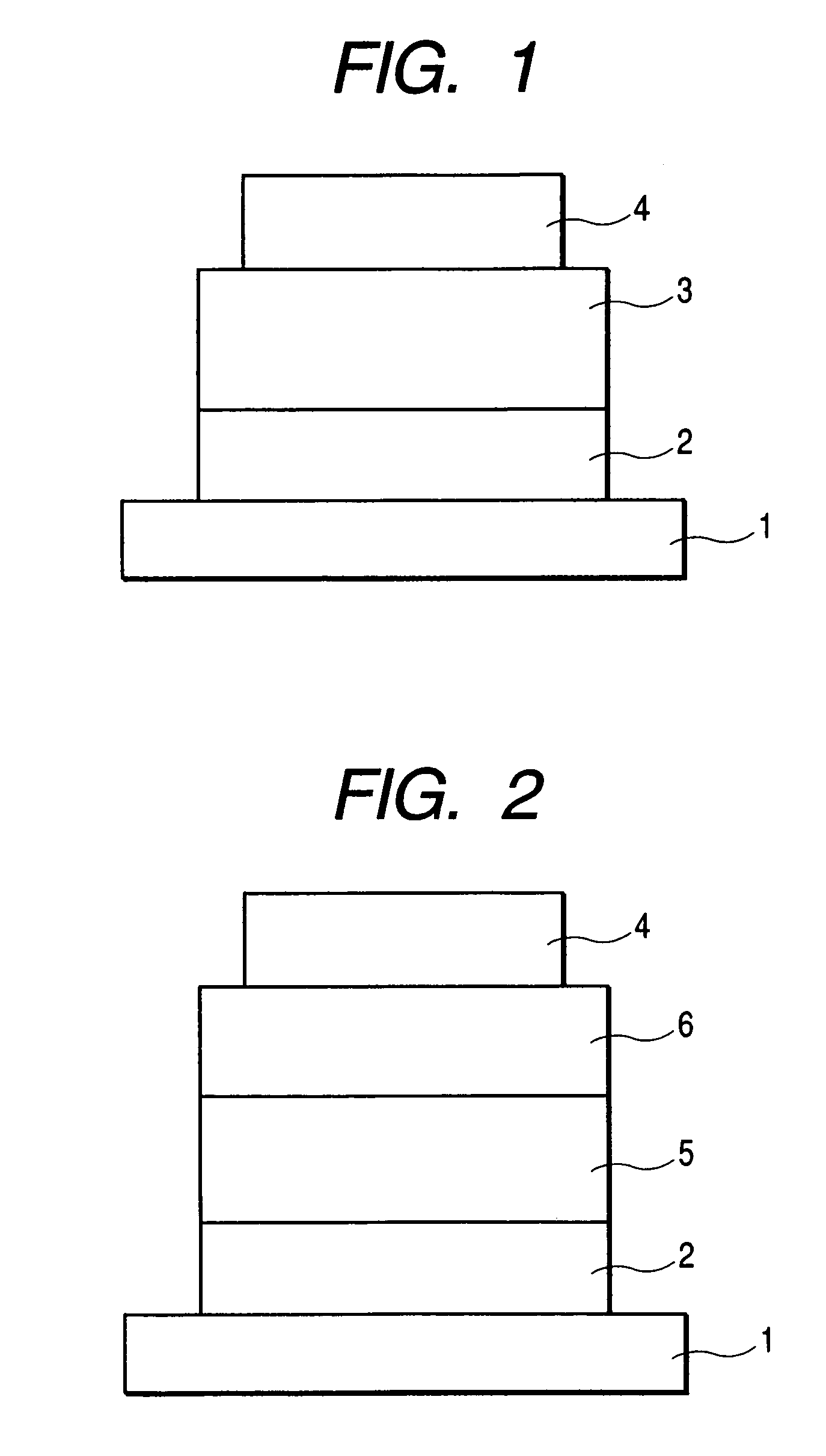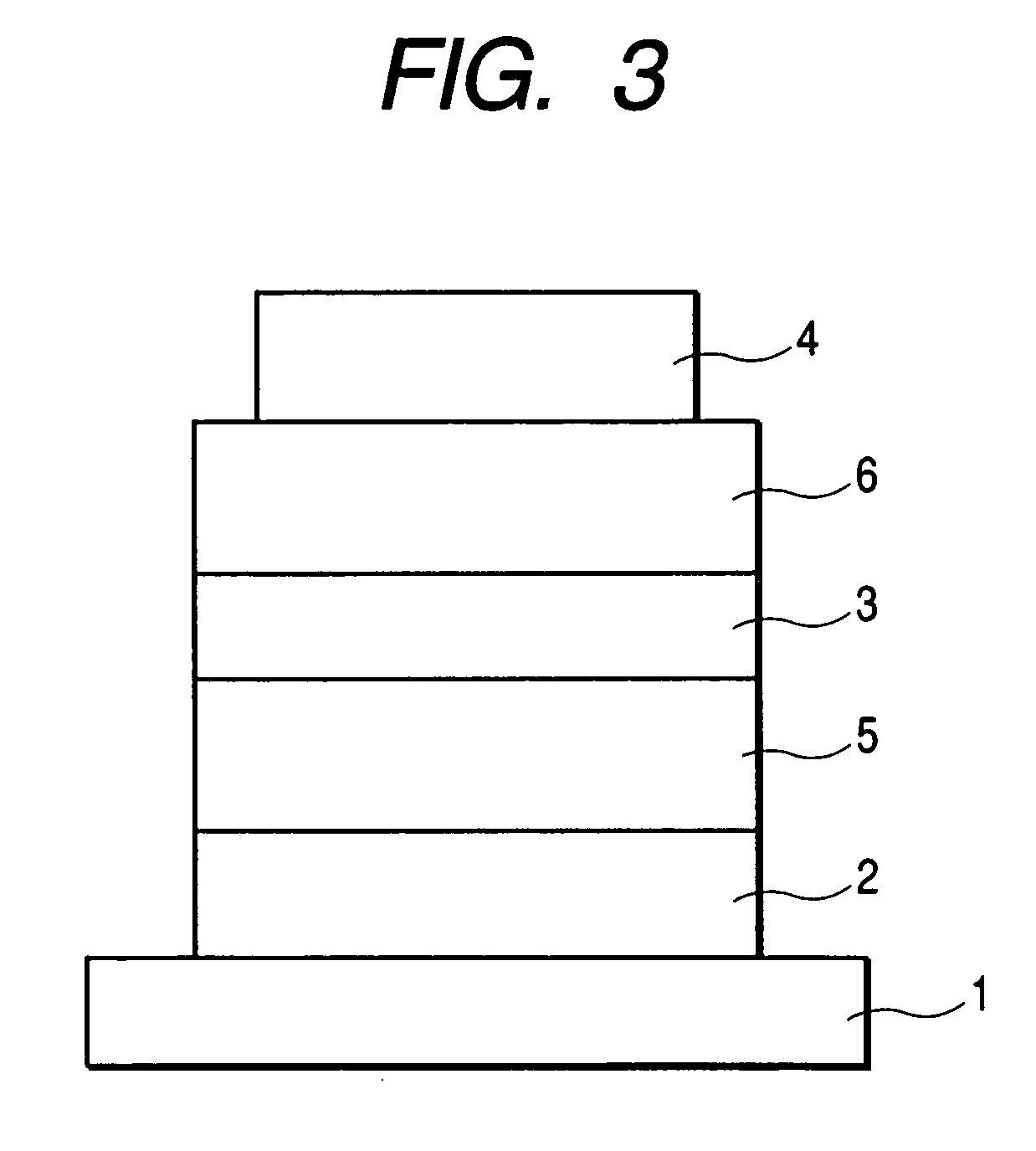Organic light-emitting device
a light-emitting device and organic technology, applied in the direction of discharge tube luminescnet screen, other domestic articles, natural mineral layered products, etc., can solve the problems of insufficient resolution and insufficient durability, and achieve the effects of high brightness, long life and high efficiency
- Summary
- Abstract
- Description
- Claims
- Application Information
AI Technical Summary
Benefits of technology
Problems solved by technology
Method used
Image
Examples
example 1
[0059]A device having a structure as shown in FIG. 1 was produced.
[0060]A transparent conductive supporting substrate was used which was produced by forming a film of indium-tin oxide (ITO) having a film thickness of 120 nm as an anode 2 on a glass substrate as a substrate 1 by means of sputtering method. This substrate was cleaned ultrasonically with acetone and isopropyl alcohol (IPA) in this order. After boiling cleaning with IPA, the substrate was dried. The substrate was further cleaned with UV / ozone and then was used as a transparent conducting supporting substrate.
[0061]A solution was prepared by dissolving 0.050 g of the compound shown as the above-exemplified compound No. 1 and 1.00 g of polyvinylcarbazole in 75 ml of tetrahydrofuran. Using this solution, an organic film layer (light-emitting layer 3) having a thickness of 120 nm was formed on a transparent conductive supporting substrate by means of spin coat method (2000 rpm).
[0062]Next, using a deposition material compos...
example 2
[0064]A device having a structure as shown in FIG. 2 was produced.
[0065]A hole-transporting layer 5 was formed by making α-NPD into a thin film having a thickness of 70 nm on a transparent conductive supporting substrate similar to that in Example 1 by means of vacuum vapor deposition method. Subsequently, an electron-transporting layer 6 was formed by making the exemplified compound No. 15 into a thin film having a thickness of 50 nm by means of vacuum vapor deposition method. The film formation was performed under the conditions where the degree of vacuum at the time of vapor deposition was 1.0×10−4 Pa, and the film-forming rate was 0.2 to 0.3 nm per second.
[0066]Next, a cathode 4 was formed on the above-mentioned organic layer in the same manner as in Example 1.
[0067]Using an ITO electrode as a positive electrode and an Al—Li electrode as a negative electrode, a direct current voltage of 8 V was applied to the device thus obtained, so that flow of an electric current having a cur...
example 3
[0068]A device having a structure as shown in FIG. 3 was produced.
[0069]A hole-transporting layer 5 was formed by making TPD into a thin film having a thickness of 70 nm on a transparent conductive supporting substrate similar to that in Example 1 by means of vacuum vapor deposition method. A light-emitting layer 3 was formed by making the exemplified compound No. 1 into a thin film having a thickness of 40 nm by means of vacuum vapor deposition method. An electron-transporting layer 6 was formed by making aluminum trisquinolinol into a thin film having a thickness of 25 nm by means of vacuum vapor deposition method. The film formation was performed under the conditions where the degree of vacuum at the time of vapor deposition was 1.0×10−4 Pa, and the film-forming rate was 0.2 to 0.3 nm per second.
[0070]Next, a cathode 4 was formed on the above-mentioned organic layer in the same manner as in Example 1.
[0071]Using an ITO electrode as a positive electrode and an Al—Li electrode as a...
PUM
| Property | Measurement | Unit |
|---|---|---|
| thickness | aaaaa | aaaaa |
| thickness | aaaaa | aaaaa |
| thickness | aaaaa | aaaaa |
Abstract
Description
Claims
Application Information
 Login to View More
Login to View More - R&D
- Intellectual Property
- Life Sciences
- Materials
- Tech Scout
- Unparalleled Data Quality
- Higher Quality Content
- 60% Fewer Hallucinations
Browse by: Latest US Patents, China's latest patents, Technical Efficacy Thesaurus, Application Domain, Technology Topic, Popular Technical Reports.
© 2025 PatSnap. All rights reserved.Legal|Privacy policy|Modern Slavery Act Transparency Statement|Sitemap|About US| Contact US: help@patsnap.com



